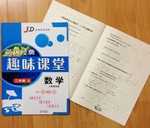题目内容
3.When it's five o'clock,people leave their office.The length of the workday,for many workers,is defined by time.They leave when the clock tells them they're done.These days,the time is everywhere:not just on clocks or watches,but on cell-phones and computers.That may be a bad thing,particularly at work.New research shows on that clock-based work schedules hinder morale and creativity.
Clock-timers organize their day by blocks of minutes and hours.For example:a meeting from 9a.m.to10a.m.,research from 10a.m.to noon,etc.On the other hand,task-timers have a list of things they want to accomplish.They work down the list,each task starts when the previous task is completed.It is said that all of us employ a mix of both these types of planning.
What,then,are the effects of thinking about time in these different ways?Does one make us more productive?Better at the tasks at hand?Happier?In experiments conducted by Tamar Avnet and Anne-Laure Sellier,they had participants organize different activities-from project planning,holiday shopping,to yoga-by time or to-do list to measure how they performed under"clock time"vs"task time".They found clock timers to be more efficient but less happy because they felt little control over their lives.Task timers are happier and more creative,but less productive.They tend to enjoy the moment when something good is happening,and seize opportunities that come up.
The researchers argue that task-based organizing tends to be undervalued and under-supported in the business culture.Smart companies,they believe,will try to bake more task-based planning into their strategies.
This might be a small change to the way we view work and the office,but the researchers argue that it challenges a widespread characteristic of the economy:work organized by clock time.While most people will still probably need,and be,to some extent,clock-timers,task-based timing should be used when performing a job that requires more creativity.It'll make those tasks easier,and the task-doers will be happier.
28.What does the author think of time displayed everywhere?C
A.It makes everybody aware of time.
B.It is a convenience for work and life.
C.It may have a negative effect on creative work.
D.It clearly indicates the fast pace of modern life.
29.What did Tamar Avnet and Anne-Laure Sellier find in their experiments about clock-timers?D
A.They seize opportunities as they come up.
B.They always get their work done in time.
C.They have more control over their lives.
D.They tend to be more productive.
30.What do the researchers say about today's business culture?B
A.It does not support the strategies adopted by smart companies.
B.It does not attach enough importance to task-based practice.
C.It places more emphasis on work efficiency than on workers'lives.
D.It aims to bring employees'potential and creativity into full play.
31.What do the researchers suggest?A
A.Task-based timing is preferred for doing creative work.
B.It is important to keep a balance between work and life.
C.Performing creative jobs tends to make workers happier.
D.A scientific standard should be adopted in job evaluation.
分析 本文讲述了时间提醒对人们工作的影响,建议工作人员的规划更多地基于任务而不是时间.
解答 28.C.细节理解题.由第二段That may be a bad thing,particularly at work,可知这会对工作产生负面影响,故选C.
29.D.细节理解题.由第四段They found clock timers to be more efficient but less happy 可知,有计时器时人们会变得更高效,故选D.
30.B.细节理解题.由第五段The researchers argue that task-based organizing tends to be undervalued and under-supported in the business culture可知,在企业文化中,基于任务的规划往往被低估.故选B.
31.A.细节理解题.由最后一段task-based timing should be used when performing a job that requires more creativity,可知作者建议在执行需要更多创造性的工作时,应该使用基于任务的时间安排,故选A.
点评 本篇文章都是细节推理题,答题的已给选项也一般不会和短文相关词语完全相同,需要考生自己理解句子,延伸推理出题目答案,比一般细节理解题偏难.

练习册系列答案
 黄冈经典趣味课堂系列答案
黄冈经典趣味课堂系列答案 启东小题作业本系列答案
启东小题作业本系列答案
相关题目
12.It is ______ of you to call on your aunt from time to time.( )
| A. | common | B. | convenient | C. | considerate | D. | concerned |